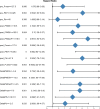A Nomogram utilizing ECG P-wave parameters to predict recurrence risk following catheter ablation in paroxysmal atrial fibrillation
- PMID: 39863909
- PMCID: PMC11762534
- DOI: 10.1186/s13019-024-03335-0
A Nomogram utilizing ECG P-wave parameters to predict recurrence risk following catheter ablation in paroxysmal atrial fibrillation
Abstract
Objective: The objective of this study is to assess the predictive utility of perioperative P-wave parameters in patients with paroxysmal atrial fibrillation (PAF) undergoing catheter ablation, and to develop a predictive model using these parameters.
Methods: A total of 213 patients with PAF undergoing catheter ablation were retrospectively analyzed. P-wave parameters were measured within 3 days preoperatively and on the day postoperatively to determine their predictive significance for postoperative PAF recurrence.
Results: Post-ablation, PAF did not recur in 168 patients, while 45 experienced recurrence. Significant differences were observed in preoperative P-wave parameters as Maximum P Wave Duration(Pmax), absolute value of P Wave Terminal Force of V1 (PtfV1) and P Wave Dispersion(Pd), postoperative P-wave parameters as P Wave Duration (PWDII, III, aVF), Pmax, P Wave Area(P-area), absolute value of PtfV1 and Pd, and changes in perioperative P-wave parameters (Delta-Pmax, Delta-PtfV1 absolute value, Delta-Pd, Delta-PWDII, III, aVF). Univariate logistic regression, receiver operating characteristic (ROC) curve analysis, and hazard ratio assessment identified predictive indicators for postoperative recurrence, including Pmax, PtfV1 absolute value, Pd, post-P area, post-PWDII, III, aVF and Delta-pwdII, III, aVF). A personalized nomogram model based on these P-wave parameters was developed. Calibration curve assessment demonstrated that the predictive performance of the nomogram for PAF recurrence following catheter ablation closely matched actual observed outcomes. ROC curve analysis indicated a sensitivity of 89.3% for the model, and decision curve analysis confirmed its significantly favorable predictive use and clinical benefits.
Conclusions: P-wave parameters like PWDШ, PWDaVF, Pmax, Pd, and PtfV1 serve as predictors of PAF recurrence following catheter ablation. The nomogram model constructed using these P-wave parameters demonstrates robust predictive performance.
Keywords: Catheter ablation; Electronic cardiogram; Nomogram model; P-wave parameters; Paroxysmal atrial fibrillation; Recurrent atrial fibrillation.
© 2024. The Author(s).
Conflict of interest statement
Declarations. Ethics approval and consent to participate: This study was conducted with approval from the Ethics Committee of Fujian Medical University Union Hospital. This study was conducted in accordance with the declaration of Helsinki. Written informed consent was obtained from all participants. Consent for publication: Not applicable. Competing interests: The authors declare no competing interests.
Figures





Similar articles
-
Maximum P-wave duration and P-wave dispersion predict recurrence of paroxysmal atrial fibrillation in patients with Wolff-Parkinson-White syndrome after successful radiofrequency catheter ablation.J Interv Card Electrophysiol. 2004 Aug;11(1):21-7. doi: 10.1023/B:JICE.0000035925.90831.80. J Interv Card Electrophysiol. 2004. PMID: 15273450
-
Multimodal data-based longitudinal prognostic model for predicting atrial fibrillation recurrence after catheter ablation in patients with patent foramen ovale and paroxysmal atrial fibrillation.Eur J Med Res. 2025 Jan 20;30(1):39. doi: 10.1186/s40001-025-02286-z. Eur J Med Res. 2025. PMID: 39833853 Free PMC article.
-
Effectiveness of P-wave ECG index and left atrial appendage volume in predicting atrial fibrillation recurrence after first radiofrequency catheter ablation.BMC Cardiovasc Disord. 2021 Apr 6;21(1):164. doi: 10.1186/s12872-021-01930-w. BMC Cardiovasc Disord. 2021. PMID: 33823799 Free PMC article.
-
Diagnostic value of electrocardiographic P-wave characteristics in atrial fibrillation recurrence and tachycardia-induced cardiomyopathy after catheter ablation.Heart Vessels. 2018 Nov;33(11):1381-1389. doi: 10.1007/s00380-018-1179-4. Epub 2018 Apr 30. Heart Vessels. 2018. PMID: 29713820
-
The amplitude of fibrillatory waves on leads aVF and V1 predicting the recurrence of persistent atrial fibrillation patients who underwent catheter ablation.Ann Noninvasive Electrocardiol. 2013 Jul;18(4):352-8. doi: 10.1111/anec.12041. Epub 2013 Jan 20. Ann Noninvasive Electrocardiol. 2013. PMID: 23879275 Free PMC article.
References
-
- Bisbal F, Baranchuk A, Braunwald E, Bayés de Luna A, Bayés-Genís A. Atrial failure as a clinical entity: JACC Review Topic of the Week. J Am Coll Cardiol. 2020;75(2):222–232. 10.1016/j.jacc.2019.11.013. PMID: 31948652. - PubMed
-
- Thomas SP, Sanders P. Catheter ablation for atrial fibrillation. Heart Lung Circ. 2012;21(6–7):395–401. 10.1016/j.hlc.2012.03.122. Epub 2012 May 9. PMID: 22575531. - PubMed
-
- Chen LY, Ribeiro ALP, Platonov PG, Cygankiewicz I, Soliman EZ, Gorenek B, Ikeda T, Vassilikos VP, Steinberg JS, Varma N, Bayés-de-Luna A, Baranchuk A. P Wave parameters and indices: a critical appraisal of clinical utility, challenges, and future research-a consensus document endorsed by the international society of electrocardiology and the international society for holter and noninvasive electrocardiology. Circ Arrhythm Electrophysiol. 2022;15(4):e010435. 10.1161/CIRCEP.121.010435. Epub 2022 Mar 25. PMID: 35333097; PMCID: PMC9070127. - PMC - PubMed
-
- Gajendragadkar PR, Von Ende A, Ibrahim M, Valdes-Marquez E, Camm CF, Murgia F, Stiby A, Casadei B, Hopewell JC. Assessment of the causal relevance of ECG parameters for risk of atrial fibrillation: a mendelian randomisation study. PLoS Med. 2021;18(5):e1003572. 10.1371/journal.pmed.1003572. PMID: 33983917; PMCID: PMC8118296. - PMC - PubMed
-
- Alcaraz R, Rieta JJ. Sample entropy of the main atrial wave predicts spontaneous termination of paroxysmal atrial fibrillation. Med Eng Phys. 2009;31(8):917 – 22. 10.1016/j.medengphy.2009.05.002. Epub 2009 Jun 5. PMID: 19501538. - PubMed
MeSH terms
LinkOut - more resources
Full Text Sources
Medical

